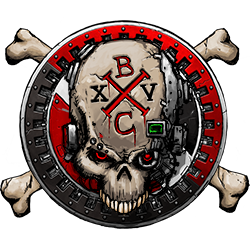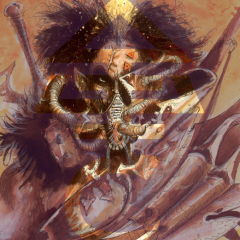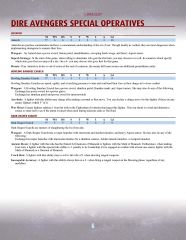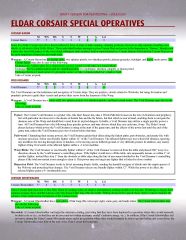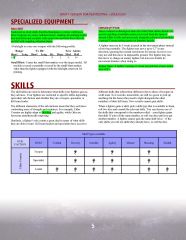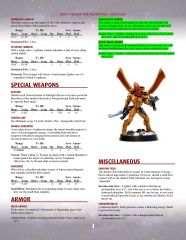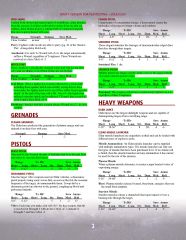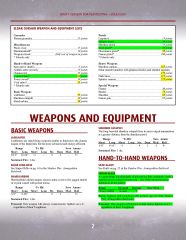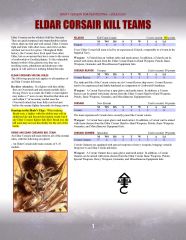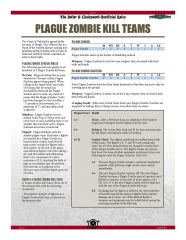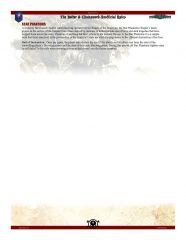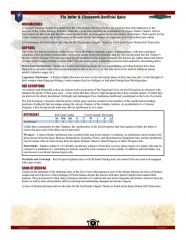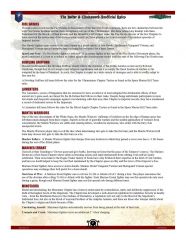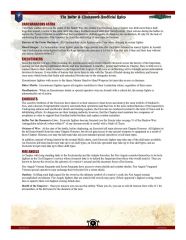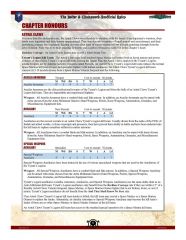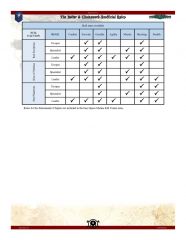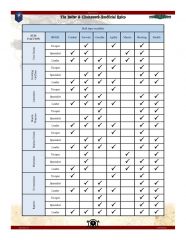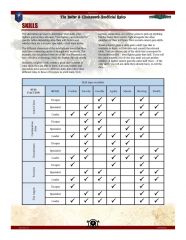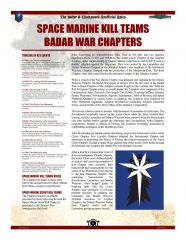Search the Community
Showing results for tags 'Shadow War 40K'.
-
As promised, here are the rules for using Striking Scorpion Aspect Warriors of the Asuryani in Shadow War: Armageddon. First, the rules: (The originally posted image links no longer work as the file has been updated. See this post for the current version.) As with the Howling Banshee Kill Teams rules, this list is based on the Craftworld Eldar [Dire Avenger] Kill Team rules, replacing the Dire Avengers Exarch and Aspect Warriors with the Striking Scorpions Exarch and Aspect Warriors; and the Guardians represent a Guardian Storm squad (so no heavy weapons, just special weapons). While I’ve retained the Battle Focus rule for the kill team, I’ve adjusted the skills to better (I hope) reflect the nature of the Striking Scorpions. Where weapons and equipment don’t already have rules in Shadow War: Armageddon (e.g., the Scorpion’s Claw is a power fist/power claw crossed with a shuriken pistol), I’ve rendered the rules as close to the 8th edition Codex: Craftworlds. There are a few items whose points I’m unsure of, and these are highlighted yellow for easy identification. Thanks for looking, and if you’re able/inclined, playtesting and providing feedback.
- 5 replies
-
- Shadow War: Armageddon
- Striking Scorpions
-
(and 1 more)
Tagged with:
-
With the Space Marine Kill Teams rules firmed up (link goes to the last version I posted, though a few minor tweaks are described in multiple replies), it's time to expand. One of my favorite events in the setting, and one that has a definite focus on the Adeptus Astartes, is the Badab War (coincidentally, one of my favorite Chapters, the Exorcists, took part in that campaign). So here's my initial stab at Chapter Honours and skills for the various Chapters that participated in the Badab War. For the most part, I took the 6th edition Chapter Tactics that Forge World provided for these Chapters, and I adapted them to Shadow War: Armageddon. For Chapters that have identified Legion lineage, I used the skill progression from those Chapters as a baseline, though I tried to apply some tweaks here and there in order to introduce some (very minor) differences. A few of the Chapters simply use their predecessors' Chapter Honours (e.g., the Novamarines are among the Primogenitors, so I reasoned that they follow the Ultramarines rules exactly). Others are very close to their predecessor, but have minor adjustments to Chapter Honours or skills or both. And some were very distinct (e.g., the Executioners are almost nothing like the Imperial Fists). Page 1 (introduction and timeline) Hidden Content Page 2 (skills - Astral Claws, Carcharadons Astra, Executioners, Exorcists, Fire Angels) Hidden Content Page 3 (skills - Fire Hawks, Howling Griffons, Lamenters, Mantis Warriors, Marines Errant, Minotaurs, Novamarines, Raptors) Hidden Content Page 4 (skills - Red Scorpions, Sons of Medusa, Star Phantoms) Hidden Content Page 5 (Chapter Honours - Astral Claws (includes rules for Tyrant's Legion kill teams)) Hidden Content Page 6 (Chapter Honours - Carcharadons Astra, Executioners, Exorcists, Fire Angels) Hidden Content Page 7 (Chapter Honours - Fire Hawks, Howling Griffons, Lamenters, Mantis Warriors, Marines Errant, Minotaurs) Hidden Content Page 8 (Chapter Honours - Novamarines, Raptors, Red Scorpions, Sons of Medusa) Hidden Content Page 9 (Chapter Honours - Star Phantoms) Hidden Content I've tried to keep balance on par with the main Space Marines Kill Team rules, but I'll need other eyes to help me with that. I have an idea that these rules might include campaign rules, at the very least a series of scenarios to play out shadow wars (i.e., squad/team level skirmish battles) within the setting of the Badab War. These might potentially include a modification of the Shadow War: Armageddon campaign rules (though that might be nothing more than changing "Promethium caches" to "victory points" or "campaign points" or somesuch. That's way down the road, though. For now, the focus is getting these rules accurate and balanced. Any input is appreciated.
- 30 replies
-
- Shadow War: Armageddon
- Badab War
-
(and 1 more)
Tagged with:
-
While the official Craftworld Eldar Kill Team rules are decent, they don't do a good job of reflecting the variety to be found within the craftworlds. A wise Autarch will use all of the tools available to her, and sometimes the shooty, but flexible, Dire Avengers just aren't the right tool for the job. Sometimes you need someone that knows how to stick sharp objects into soft flesh. Here's the good stuff before I bore you: (The originally posted image links no longer work as the file has been updated. See this post for the current version.) I initially wavered on whether or not this kill team should be Howling Banshees or Striking Scorpions. Both are stabby, each in their own unique way. Lore-wise, the Striking Scorpions are the folks you send in when you need someone to sneak in and spill some blood. The only problem was that their signature weapon is the chainsword, which has the Noisy rule in Shadow War: Armageddon, making it less than ideal for a few of the missions. Also, I really wanted to give the screaming and leaping ladies their time in the spotlight. They're a good counterpoint to the Wych Cults of the Dark Kin, and sort of a shadow of the Harlequins. Truth be told, I could easily create a variation on this list that replaces the Howling Banshees with Striking Scorpions, with the rest of the rules remaining unchanged (I'll probably do just that, but later). So I pulled the Dire Avengers out and replaced them with Howling Banshees. I also replaced the Guardian Defender squad, identified by the option to take the weapons platforms and not special weapons, and replaced them with Storm Guardians. This change, more than anything, defines the shift from the Craftworld Eldar [Dire Avengers] Kill Team to the Howling Banshees Kill Team. Able to take power swords and special weapons (flamer or fusion gun) and not able to take the weapons platforms dramatically changes the whole dynamic of how this kill team operates compared to their blue-armored brothers. Sure, the Guardians are the New Recruits of both squads, so they'll be half or less of the total kill team composition, but a shuriken cannon weapons platform operates in a vastly different manner from a flamer, providing good covering fire from a distance without having to get within charging range. Other than those two (monumental) changes, everything else remained the same - Battle Focus, skills, and special operatives. I really don't like the special operatives choices in the Craftworld Eldar [Dire Avengers] Kill Team rules (you can see why here, scroll down to the fifth paragraph below the images), and I really wanted to change them. However, it didn't feel right in that it would have changed too much from the Craftworld Eldar [Dire Avengers] Kill Team list. So much as I'd like to change those special operatives, any Aspect Warrior Shrine kill team lists I come up with will keep those three - Autarch, Wraithblade, Wraithguard. This is just my first stab at this list, and it will be revised based on playtesting and feedback. Thanks!
- 10 replies
-
- Shadow War: Armageddon
- Howling Banshees
-
(and 1 more)
Tagged with:
-
One of the diversions I had when reading the Craftworld Eldar Kill Teams rules was that those rules were a bit too limited. The Eldar of the craftworlds have a rich diversity that just isn't represented in that list. That list should really have been called a "Dire Avengers Kill Team." It occurred to me that there are probably plenty of occasions on which crack Guardian squads, whether Guardian Defenders or Storm Guardians, have been dispatched on special missions that are within the realm of what Shadow War: Armageddon covers. So I've crafted this set of kill team rules as an alternative to the official Craftworld Eldar [Dire Avengers] Kill Team. Here's the good stuff, before I get all boring with words: (The originally posted image links no longer work as the file has been updated. See this post for the current version.) I used the Black Guardians of Craftworld Ulthwé as the package, though the list could easily represent a crack Guardian (Storm or Defender) squad from any craftworld. I retained the Battle Focus special rule found in the Craftworld Eldar [Dire Avenger] Kill Team rules since it seemed appropriate. I also kept the same skills options. I used the [Ordo Xenos] Inquisition Kill Team rules as a model for the basic enhancement that the [Trooper] Black Guardians get, allowing the player to make each separate Guardian a "Storm" or "Defender" Guardian. As with my Eldar Corsair Kill Team rules, I've introduced the wildcard of a psyker into the kill team, this time the kill team's Leader is a Warlock. That appropriate from a lore perspective, but it does create problems, especially since the Warlock, unlike the Eldar Corsair Void Dreamer, has psyker powers that affect the enemy. Okay, one power, but it's a good one. Destructor. It's not as good as the 1st edition version, but a witchfire shooting attack can be a pretty dramatic thing if you're on the receiving end. By my estimation, the Ammo Roll does a decent job of introducing a sort of drawback. Instead of suffering Perils of the Warp is in regular WH40K, though, the Warlock loses the psyker power for the rest of the mission. The way I see it, when used "correctly," the Warlock won't be a walking gun. He should be using his powers to improve the performance of the other members of the kill team (via his other two psyker powers). Your input on this is welcome (especially if it's based on playtesting). Otherwise, the basic kill team rules, along with the weapons and equipment, do a fair job of representing either a Guardian Storm Squad, a Guardian Defender Squad, or a mix, all depending upon how the player applies their bonus WS/BS and equips the fighters. One area where I deviated strongly from the Eldar Craftworld [Dire Avenger] Kill Team rules was in the special operatives. I didn't like the Autarch in the Eldar Craftworld [Dire Avengers] Kill Team because it just didn't seem right that the army's general would lead a small mission. Nor did it seem right that the ghost warriors would go on a special mission without either a Warlock or a Spiritseer to keep them from getting lost in the sauce. So I swapped out all three for other elite warriors. I decided to use Exarchs of various shrines. I figured a decent spread of three special operatives would include one that was shooty, one that was stabby, and one that was "other" ("jumpy" in this case). The Shining Spears and Crimson Hunters weren't options (neither bikes nor flyers really have a place in Shadow War: Armageddon). The Shadow Spectres were out because they're a niche Forge World Aspect Warrior Shrine and not in the main WH40K codex. So my shooty options were either the Fire Dragons or the Dark Reapers; my stabby options were either the Howling Banshees or the Striking Scorpions; and my jumpy options were either the Swooping Hawks or the Warp Spiders. Since the Fire Dragons are meant to be used against armor/vehicles/fortifications and none of those really has a place in Shadow War: Armageddon, I went with the Dark Reapers. The stabby option was another story altogether. In the end, I decided to go with the Striking Scorpions because I was using the Howling Banshees for something else. The jumpy option was a toss up. In the end, I went with the Swooping Hawks for no other reason than they were introduced to the game first. I don't really have a dog in the fight, though, so if there is strong feedback to shift over the Warp Spiders, I might be compelled to do that. One thing I did was make the kill team larger than normal by allowing it to include up to 12 fighters. That was a complete SWAG, so I'll be playtesting against a Craftworld Eldar [Dire Avengers] Kill Team of 10 models to see how the two different kill teams balance out; and I'll adjust the maximum size of the Black Guardians kill team accordingly. Anyways, the rules you can see by clicking the images above are my first draft, pending revisions based on playtesting and feedback. Thanks in advance.
- 6 replies
-
- Shadow War: Armageddon
- Black Guardians
-
(and 1 more)
Tagged with:
-
From the album: Aeldari
Special operatives-
- Shadow War: Armageddon
- Shadow War 40K
-
(and 2 more)
Tagged with:
-
From the album: Aeldari
Special operatives-
- Shadow War: Armageddon
- Eldar Corsairs
- (and 3 more)
-
From the album: Aeldari
Weapons and equipment, continued; skills-
- Shadow War: Armageddon
- Eldar Corsairs
- (and 3 more)
-
From the album: Aeldari
Weapons and equipment, continued-
- Shadow War: Armageddon
- Eldar Corsairs
- (and 3 more)
-
From the album: Aeldari
Weapons and equipment, continued-
- Shadow War: Armageddon
- Eldar Corsairs
- (and 3 more)
-
From the album: Aeldari
Weapons and equipment-
- Shadow War: Armageddon
- Eldar Corsairs
- (and 3 more)
-
From the album: Aeldari
Basic Eldar Corsair kill team rules-
- Shadow War: Armageddon
- Eldar Corsairs
- (and 3 more)
-
From the album: Shadow War: Armageddon
-
- Shadow War: Armageddon
- Hive of the Dead
- (and 4 more)
-
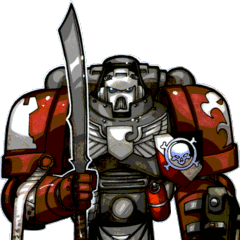
Space Marine Kill Teams Badab War Chapters V 1 2 9
Brother Tyler posted a gallery image in Adeptus Astartes/Legiones Astartes
From the album: Shadow War: Armageddon
-
- Shadow War: Armageddon
- Badab War
-
(and 1 more)
Tagged with:
-

Space Marine Kill Teams Badab War Chapters V 1 2 8
Brother Tyler posted a gallery image in Adeptus Astartes/Legiones Astartes
From the album: Shadow War: Armageddon
-
- Shadow War: Armageddon
- Badab War
-
(and 1 more)
Tagged with:
-

Space Marine Kill Teams Badab War Chapters V 1 2 7
Brother Tyler posted a gallery image in Adeptus Astartes/Legiones Astartes
From the album: Shadow War: Armageddon
-
- Shadow War: Armageddon
- Badab War
-
(and 1 more)
Tagged with:
-

Space Marine Kill Teams Badab War Chapters V 1 2 6
Brother Tyler posted a gallery image in Adeptus Astartes/Legiones Astartes
From the album: Shadow War: Armageddon
-
- Shadow War: Armageddon
- Badab War
-
(and 1 more)
Tagged with:
-

Space Marine Kill Teams Badab War Chapters V 1 2 5
Brother Tyler posted a gallery image in Adeptus Astartes/Legiones Astartes
From the album: Shadow War: Armageddon
-
- Shadow War: Armageddon
- Badab War
-
(and 1 more)
Tagged with:
-

Space Marine Kill Teams Badab War Chapters V 1 2 4
Brother Tyler posted a gallery image in Adeptus Astartes/Legiones Astartes
From the album: Shadow War: Armageddon
-
- Shadow War: Armageddon
- Badab War
-
(and 1 more)
Tagged with:
-

Space Marine Kill Teams Badab War Chapters V 1 2 3
Brother Tyler posted a gallery image in Adeptus Astartes/Legiones Astartes
From the album: Shadow War: Armageddon
-
- Shadow War: Armageddon
- Badab War
-
(and 1 more)
Tagged with:
-

Space Marine Kill Teams Badab War Chapters V 1 2 2
Brother Tyler posted a gallery image in Adeptus Astartes/Legiones Astartes
From the album: Shadow War: Armageddon
-
- Shadow War: Armageddon
- Badab War
-
(and 1 more)
Tagged with:
-

Space Marine Kill Teams Badab War Chapters V 1 2 1
Brother Tyler posted a gallery image in Adeptus Astartes/Legiones Astartes
From the album: Shadow War: Armageddon
-
- Shadow War: Armageddon
- Badab War
-
(and 1 more)
Tagged with:
-
http://www.bolterandchainsword.com/index.php?app=downloads&module=display§ion=screenshot&id=651 File Name: Dire Avengers Kill Team for SWA File Submitter: Ioldanach File Submitted: 01 Oct 2019 File Category: Wargaming Downloads Rules for using Asuryani Dire Avengers in the Shadow War: Armageddon game. This is essentially the official "Craftworld Eldar Kill Team" with different special operatives. The Autarch remains, but the Dark Reapers Exarch has replaced the Wraithguard and the Howling Banshees Exarch has replaced the Wraithblade. Click here to download this file
-
- Shadow War: Armageddon
- Shadow War 40K
-
(and 3 more)
Tagged with:
-
http://www.bolterandchainsword.com/index.php?app=downloads&module=display§ion=screenshot&id=650 File Name: Ynnari Kill Team for SWA File Submitter: Ioldanach File Submitted: 01 Oct 2019 File Category: Wargaming Downloads Rules for using Ynnari in the Shadow War: Armageddon game. Click here to download this file
-
- Shadow War: Armageddon
- Shadow War 40K
-
(and 2 more)
Tagged with:
-
http://www.bolterandchainsword.com/index.php?app=downloads&module=display§ion=screenshot&id=649 File Name: Striking Scorpions Kill Team for SWA File Submitter: Ioldanach File Submitted: 01 Oct 2019 File Category: Wargaming Downloads Rules for using Striking Scorpions in the Shadow War: Armageddon game. Click here to download this file
-
- Shadow War: Armageddon
- Shadow War 40K
- (and 3 more)
-
http://www.bolterandchainsword.com/index.php?app=downloads&module=display§ion=screenshot&id=647 File Name: Black Guardians Kill Team for SWA File Submitter: Ioldanach File Submitted: 01 Oct 2019 File Category: Wargaming Downloads Rules for using Aeldari Black Guardians of Ulthw
-
- Shadow War: Armageddon
- Shadow War 40K
-
(and 3 more)
Tagged with:
